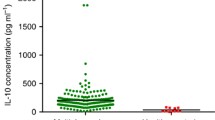Abstract
Tumor necrosis factor-α (TNF-α) is important for function, differentiation, and transformation of B-lymphocytes in multiple myeloma (MM) but can also induce apoptosis of myeloma cells. Based on this opposite effect, it is very crucial to analyze the correlation of the serum level of TNF-α with clinical parameters of the patients. In this article, we analyzed 18 MM patients, 48% male and 52% female, with a mean age of 52 yr (range: 35–81 yr), clinical stage I in 21.4%, stage II in 26.4%, and stage III in 52.2% of patients. Patients with advanced clinical stage, presence of osteolysis, and elevated lactate dehydrogenase (LDH) had a significant difference (Mann-Whitney U-test, p<0.05) in the serum level of TNF-α in comparison with those in the early stage, without osteolysis, and normal LDH. The correlation of individual values of TNF-α with the percentage of plasma cells in the bone marrow, LDH, β2-microglobulin, fibrinogen, and sedimentation rate was significant (p<0.05). However, we have not found a significant correlation between TNF-α and concentration of hemoglobin, the number of white blood cells or platelets (p>0.05). We concluded that our data indicate determination of TNF-α as a good parameter for estimation of tumor mass presence, among individual patients with MM, and may by used for monitoring during application of different therapy protocols.
Similar content being viewed by others
References
Durie, B.M.G. and Salmon, S.E. (1975). A clinical staging system for multiple myeloma. Correlation of measured myeloma cell mass with presenting clinical features, response to treatment, and survival. Cancer 36, 842–849.
Berenson, J.R., Sjak-Shie, N.N. and Vescio, R.A. (2000). The role of human and viral cytokines in the pathogenesis of multiple myeloma. Semin. Cancer Biol. 10, 383–391.
Greipp, P.R. and Kyle, R.A. (1996). Staging, kinetics, and prognosis of multiple myeloma, in: Neoplastic Disease of the Blood (Wiernik, P., Canelos, G., Ducher, J. and Kyle, R., (eds), pp537–559, Churchill Livingstone, New York.
Hallek, M., Bergsagel, P.L. and Anderson, K.C. (1998). Multiple myeloma: increasing evidence for a multiple transformation process. Blood 91, 3–21.
Hatzoglou, A., et al. (2000). TNF receptor family member BCMA (B cell maturation) associated with TNF receptor-associated factor (TRAF) TRAF 2, and TRAF3, and activates NF-kappa B, elk-1, c-Jun N terminal kinase, and p38 mitogen activated protein kinase. J. Immunol. 165, 1322–1330.
Dunn, T.M., Wormsley, S., Taub, F.E. and Pontzer, C.H. (2000). Increased T cell cytotoxicity by Betathine-induced upregulation of TNF-alpha. Int. J. Immunopharmacol. 22, 213–227.
Borset, M., et al. (1999). A apoptosis, proliferation and NF-kB activation induced by agonist Fas antibodies in the human myeloma cell line OH-2: amplification of Fas-mediated apoptosis by tumor necrosis fctor. Eur. J. Haematol. 63, 345–353.
Hata, M., Matsuzaki, K. and Tkatsuki, K. (1990). Autocrine growth by two cytokines, interleukin 6 and tumor necrosis factor alpha, in the myeloma cell line KHM-1A. Acta Hematol. 83, 133–136.
Borset, M., Vaage, A., Brekke, O.L. and Helseth, E. (1994). TNF and IL-6 are potent growth factor for OH-2, a novel human myeloma cell line. Eur. J. Hematol. 53, 31–35.
Pisa, P., Stenke, L., Bernell, P., Hansson, M. and Hast, R. (1990). Tumor necrosis factor-alpha and interferon-gamma in serum of multiple myeloma patients. Anticancer Res. 10, 817–820.
Usnarska-Zubkiewicz, L. (1998). Level of interleukin-6 (IL-6), soluble interleukin-6 receptors (sIL-6R) and tumor necrosis factor alpha (TNF-alpha) in untreated and progressing multiple myeloma. Pol. Arch. Med. Wewn. 1, 30–37.
Desser, L., Sakalova, A., Zavdova, E., Holomanova, D. and Mohr, T. (1997). Concentration of soluble tumor necrosis factor receptor, β2-microglobulin, IL-6, and TNF in serum of multiple myeloma patients after chemotherapy and after combined enzyme-chemotherapy. Int. J. Immunother. 13, 121–130.
Verhoef, G.E., de Shower, P., Ceuppens, J.L., Van Damme, J., Goossens, W. and Boorgaerts, M.A. (1992). Measurement of serum cytokine level in patients with myelodisplastic syndromes. Leukemia 6, 1268–1272.
Jurišić, V., Spužić, I., and Konjević, G. (1999). A comparison of the NK cell cytotoxicity with effects of TNF-alpha against K-562 cells, determined by LDH release assay. Cancer Lett. 138, 67–72.
Decker, T. and Lohmann-Matthes, M.L. (1988). A quick and simple method for the quantification of lactate dehydrogenase release in measurements of cellular cutotoxicity and tumor necrosis factor (TNF) activity. J. Immunol. Methods 115, 61–69.
Jourdan, M., et al. (1999). Tumor necrosis factor is survival and proliferation factor for human myeloma cells. Eur. Cytok. Network 10, 65–70.
Jurišić, V., Konjević, G., Banićević, B., Djuričić, B., and Spužić, I. (2000). Different alterations in lactate dehydrogenase activity and profile of peripheral blood mononuclear cells in Hodgkin’s and non-Hodgkin’s lymphomas. Eur. J. Haematol. 64, 259–266.
Rodon, P., et al. (2001). Multiple myeloma in elderly patients: presenting and features and outcome. Br. J. Haematol. 66, 11–17.
Davies, F.E., et al. (2000). High-producer haplotypes of tumor necrosis factor alpha and lymphotoxin alpha are associated with an increased risk of myeloma and have an improved progression-free survival after treatment. J. Clin. Oncol. 18, 2843–2851.
Dring, A.M., et al. (2001). Interleukin 6 tumor necrosis factor and lymphotoxin polymorphism in monoclonal gammopathy of uncertain significance and multiple myeloma. Br. J. Haematol. 112, 249–250.
Author information
Authors and Affiliations
Corresponding author
Rights and permissions
About this article
Cite this article
Jurišić, V., Čolović, M. Correlation of sera TNF-α with percentage of bone marrow plasma cells, LDH, β2-microglobulin, and clinical stage in multiple myeloma. Med Oncol 19, 133–139 (2002). https://doi.org/10.1385/MO:19:3:133
Received:
Accepted:
Issue Date:
DOI: https://doi.org/10.1385/MO:19:3:133




